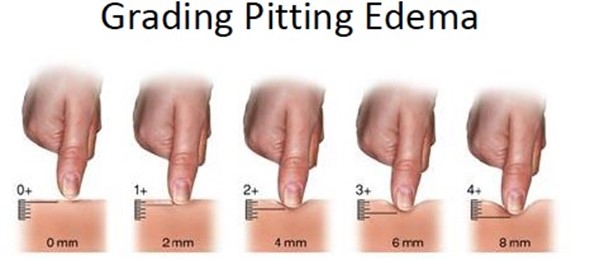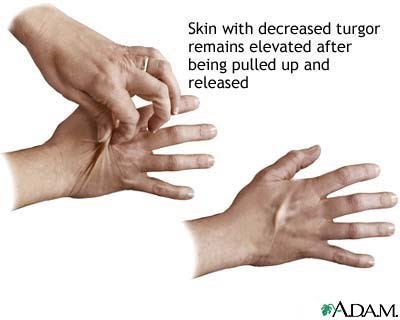A nurse is performing a physical assessment of a patient who is experiencing fluid volume excess. Upon examination of the patient's legs, the nurse documents: Pitting edema; 8-mm pit. Pit remained for 4 minutes after pressing. What grade of edema has this nurse documented?
2+ Pitting Edema
3+ Pitting Edema
1+ Non-Pitting Edema
4+ Pitting Edema
The Correct Answer is D
A. 2+ Pitting Edema: This refers to moderate pitting edema where the indentation is approximately 4 mm and disappears within 10-15 seconds.
B. 3+ Pitting Edema: This refers to moderately severe pitting edema where the indentation is approximately 6 mm and may last longer than 1 minute but does not remain for as long as 4 minutes.
C. 1+ Non-Pitting Edema: This grade refers to mild pitting edema with a 2 mm indentation that quickly disappears within a few seconds.
D. 4+ Pitting Edema: 4+ pitting edema is characterized by a very deep pit (approximately 8 mm) that may last 2-5 minutes or more. This matches the scenario where the pit is 8 mm deep and remains for 4 minutes.

Nursing Test Bank
Naxlex Comprehensive Predictor Exams
Related Questions
Correct Answer is C
Explanation
The correct answer is choice C: Skin fold returns to its usual shape quickly when released. When assessing skin turgor, the nurse is checking for the elasticity and hydration of the skin. In a normal assessment, when the skin fold is lifted or pinched, it should return to its usual shape quickly when released. This indicates good skin turgor, which is an indication of proper hydration. If the skin fold is difficult to lift or pinch (choice A), this indicates poor skin turgor and possible dehydration. If an indentation of 2 mm remains after releasing the skin fold (choice B), this indicates poor skin turgor and possible dehydration. If the skin fold returns to its usual shape slowly when released (choice D), this may indicate a decrease in skin elasticity and possible dehydration.

Correct Answer is A
Explanation
The correct answer is choice A. When performing hygiene care for a client with an indwelling catheter, the nurse should plan to cleanse the catheter from the meatus outward using mild soap and warm water. This helps to prevent infection and ensure proper hygiene. Using the same cleansing cloth for cleaning the perineal area and catheter tubing (choice B) is not recommended as it can cause contamination and increase the risk of infection. The use of chlorhexidine gluconate (CHG) to cleanse the perineal area (choice C) is not necessary for routine catheter care and should only be used for specific indications such as preventing infection during surgery. Therefore, the nurse should always follow proper hygiene protocols and cleanse the catheter from the meatus outward using mild soap and warm water when caring for a client with an indwelling catheter.
Whether you are a student looking to ace your exams or a practicing nurse seeking to enhance your expertise , our nursing education contents will empower you with the confidence and competence to make a difference in the lives of patients and become a respected leader in the healthcare field.
Visit Naxlex, invest in your future and unlock endless possibilities with our unparalleled nursing education contents today
Report Wrong Answer on the Current Question
Do you disagree with the answer? If yes, what is your expected answer? Explain.
Kindly be descriptive with the issue you are facing.
